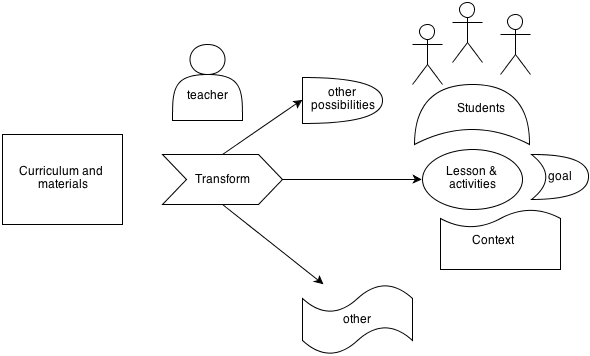Recently I was reading a book Clinical Supervision and Teacher Development
The following are summary notes of Chapter 3 Using clinical supervision to promote effective teaching.
Characteristics of Good Teaching in Students’ Mind?
Niss(Nice)
- Nice(respect, patient and easy to get along with)
- Interesting(makes subject interesting and fun with students engaged)
- Sense of humor(tell jokes and smiles a lot)
- Sensitive to students’ need( Listent to students’ question and make changes to help students learn )
Teacher characteristics associated with gain in students’ academic achievement?
Creati
- Clarity
- Raise Variety(of materials, methods, question types and levels)
- Enthusiasm
- avoid harsh criticism
- Task-oriented
- Indirect teaching style
Substantive interaction that increase students’ at-task time:
Equal
- Explain(content to students)
- questioning
- using feedback
- assistance
- list the steps or tasks(chunlei added)
Effective Classroom Preconditions:
Amazing
- Attention and motivation
- Meaningful(students can find personal meaning in the information being presented)
- Applications(opportunities to practice using new information)
- Include both lower-coginitive and higher-cognitive tasks or questions
- Group work process in the classroom
Notes taken from another book chapter-Glickman -chapter 4.pdf
Research on effective instruction() indicates that effective instruction is based on adaption of curriculum and materials to local settings and particular learning goals. In other words, effective teachers think about what they are currently doing, assess the results of their practice, explore with each other new possibilities for teaching students, and are able to consider students’ perspectives.
The following was added at 2014/10/30
Evidence based Teaching notes
Evidence-Based Teaching: A Practical Approach by Geoff Petty
==Expert teachers set challenging goals: deep learning==
==Expert teachers had very deep understanding of their subject and the teaching and learning of the subject==
Their subject knowledge was more integrated, interrelated and built around general principles.
This deep learning enabled them to “make lessons uniquely their own by changing, combining, and adding to them according to their students’ needs and their own goals”.
p310
The expert teacher knowledge of the learning process was similarly deeper than that of experienced teachers. This enabled them to predict and avoid difficulties that students might have , and to see what was happening in their classrooms in terms of a deeper set of principles relating how students learn.
This mean that expert teacher were better able to diagnose what was happening in their classrooms, and to adapt. They were more responsive to their students as a result. The teaching and learning principles they used were probably something like those outlined in Chapter 14.
==Expert teachers monitor learning and provide feedback==
Aim for evolution rather than revolution. Trying new methods one at a time is usually best, or your students will get unsettled even if you don’t.
Teachers touch students’ lives for ever - so it’s worth the effort to make powerful methods work.
Graham Gibbs(1992)
action research approach advice:
Involve others
Identify the problem clearly
Use research evidence to convince others and to find promising strategies
Start where you can
Start small
Don’t reinvent the wheel
Involve the students
Changes as you go along
p318
Review
we review our teaching in particular lesson or sequence of lessons, and look for evidence for what worked and what didn’t.
Difficulties: Being brave enough to collect evidence that might be uncomfortable, andhones enough to face up to problems without blaming ourselves or our students
Learn
we try to lean from this review, not just what worked or didn’t, but why. This creates general principles that we can apply elsewhere.
Difficulties: Asking ‘why’ persistently enough to enable us to lean the root cause of success or failure. Being able to ‘bridge’ this learning to other context by asking ‘where else in my teaching could I use what I have just learned?’
Apply
We plan an experiment, perhaps adapting what we did in an earlier ‘Do’ phase.
Difficulties: Finding the courage, time and inclination to do things differently.
Do
we carry out our experiment. The cycle repeats.
p164
Seven principles common to high-quality leaning and achievement
1 student must see the value of the learning
2 students must believe they can do it
3 challenging goals
the goal involves student activity on constructive methods
the goal involves reasoning not just reproduction
high participation rate
students have their audience, variety and fun
4 feedback and dialogue on progress towards goal
students need ‘medals’ that give information about the extent to which they have achieved the goals
students need ‘missions’ that describe how to improve and progress
students need to develop a growing understanding of the goals
5 establish the structure of information and so its meaning
from known to unknown
from concrete to abstract
the structure first, then add the detail
6 time and repetition
multiple context: examples and non-examples in many different contexts in order to ‘get’ them
multiple perspectives: student need to see what they are leaning through different ‘spectacles’. SOLO
multiple representations: right- and left-brain
7 teach skills as well as content
The PAR model
Present Apply & Review
end notes
有趣的是,脑科学和认知科学也提出了若干原则和规律:
基于神经生物学研究的证据,Zull在2002年提出了3条规律:
- 认识到情感因素的关键性作用。
- 帮助学生建立自己掌控学习的感觉。
- 学习必须基于自己已有的神经网络(已有知识),即使这个网络是错误的。
脑科学的研究发现,情绪是智慧的高级组织者,情绪能够指导认知进程和影响推理。例如长期高水平的皮质醇最终将导致与学习和记忆有关的海马神经元的损伤 ,即使是短时间的高水平皮质醇也会对短期记忆产生影响 。情绪对学习的影响具有两重性,轻松、愉快的情绪有利于学生的学习和健康发展,而过于紧张、沮丧、愤怒的情绪则不利于学生的学习。
此外无论是教育研究还是认知科学研究都显示,元认知的发展对于学习非常关键
学习者已有的知识对于学习有直接和重大的影响。学生并非头脑空空的来到教室,他们通过生活经验以及人际交流已经形成了很多概念和认识,这些概念或者完全错误,或者不完全,或者相对合理,不一而同,但是都对相关概念的学习有着重要的影响,科学教育研究者称之为前科学概念。而其脑科学的基础就是学生在已有的神经网络的基础上建造新的神经网络进而执行新的认知功能。
Boettcher2007年根据脑科学研究成果,提出的核心学习原则:
1:每一个结构化的学习经验都有四个元素(学习者、教师、知识、环境),它们以学习者为中心。
2:每一个学习经验都包括能够与学习者的相互作用环境。
3:我们塑造工具,工具也塑造我们。
4:教师是学习经验的导演。
5:学习者具有与该学习经验有关的个体知识、技能和态度。
6:学习者都具自己特定的最近发展区作为建构有用知识的基础。
7:概念并不是语句而是有组织的错综复杂的知识簇。
8:学习者都不需要学习所有内容,但是需要学习核心概念。
9:学习目标不同,所需教学也不同。
10:在其他条件一线的情况下,更多学习任务时间等价于更多的学习。
References:
Boettcher, J. (2007). Ten core principles for designing effective learning environments: Insights from brain research and pedagogical theory. Innovate: Journal of Online Education, 3(3), n3.
Zull, J. E. (2002). The art of changing the brain: Enriching the practice of teaching by exploring the biology of learning. Sterling, VA: Stylus.

